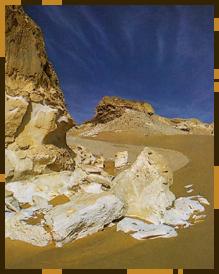Oases
Ancient
and modern civilisations have always found an ideal environment
in the Nile Valley, with its fertile land and its rhythm of
annual inundations. Along the Nile there is a stratification
of thousands of years of human occupation, from Prehistory
down to the present day, including famous pharaonic monuments
which annually attract masses of tourists from all over the
world.
 |
This
does not mean, however, that Egypt is confined to the Nile
Valley. The country (and the historical events) also include
the mountainous area which stretches between the Valley and
the Red Sea, called the Eastern Desert, and the vast land
west of the Valley to the border with Libya, called the Western
(or Libyan) Desert. Although the Valley is certainly the most
inhabited and largest fertile area of Egypt, it would be a
mistake to consider the Eastern and Western Desert as desolate
and inhospitable lands. The Western Desert, in particular,
contains large depressions where the emerging water has created
a number of oases of various sizes. Nowadays some of them
have been turned into vast cultivations. Apart from these
green areas, there is more life in the desert than many people
would expect, either human, animal or vegetal. This life
is simply of a different kind - less striking because since
it is more subdued to the dominant nature.
|

|
The
Egyptian Western Desert includes areas which differ considerably
one from the other. Rock desert, flat plateau, fertile depressions,
chains of dunes, and down at the "triple" point between Egypt,
Libya and Sudan, large mountains create different types of
desert landscape each with its own inhabitants. The only area
where life is virtually absent is the so-called Great Sand
Sea, the largest and most dangerous dune field of the world,
able to swallow and cancel anything which crosses its path.
In
the more hospitable areas of the desert, the Bedouins have
always led a nomadic life, moving from spring to spring with
their light tents and livestock, hardly leaving any trace.
The scarce emerging water also supports a large number of
animal species, including insects, mice, hedgehogs, cats,
foxes and gazelles. The latter are extremely difficult to
spot, but fennec foxes seem to materialise almost anywhere
at night to check if a desert camp might have brought anything
interesting - from a gastronomical point of view.
The
large depressions where the ground is close to the water table
contain the five major oases of the Western Desert namely:
Siwa, Bahariya, Farafra, Dakhla, Kharga, plus the Fayum, which
is the closest to the Nile Valley. Recently Farafra, Dakhla
and Kharga have joined into one province, called the New Valley,
and ambitious plans have been laid down to increase the water
supply and improve the agriculture of the whole area.
From
an archaeological point of view, the oases provide evidence
of human occupation since prehistoric times, when huge lakes
occupied most of the depressions. The pharaonic period is
attested in a very uneven way, while recent excavations are
adding a lot to our knowledge of the Late Period and the Roman
rule. Christian and Islamic remains are also present. Also
taking into account the beautiful landscape and the products
of the local community. As you acn see, there is a lot to
attract the increasing tourists.
(Corinna
Rossi)
|
|